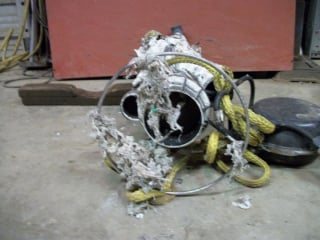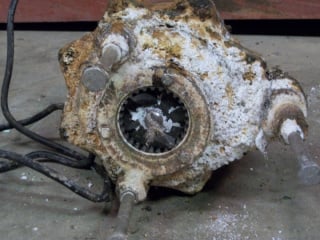TIPS AND IMPORTANT INFO...
SEVERE WEATHER PROCEDURES
PLEASE BE AWARE that during times of inclement weather we may close our office early or in some severe cases not open the office at all. You can contact our office at (903) 887-7103 to confirm that we are open before traveling. Closings will be published here on our website, with KCKL Radio, and with Henderson County now on facebook
HOME OWNER INSURANCE
East Cedar Creek FWSD does not endorse, promote or otherwise recommend companies that offer water line repair insurance. Anyone considering doing business with any company offering this type of insurance should first check with the Better Business Bureau and read online reviews of their business practices before making a commitment. Always review limits of coverage and disclaimers
Fats, Oil & Grease (FOG) Problems
If you listen to the radio or watch television you have probably seen a paid advertisement from one of our major utilities in the area explaining to the listeners that FOG is one of the main reasons they experience sewer blockages. FOG effects even the smallest utility as well as the budget bottom line.
Accompanying this article are a few pictures from your sewer collection system validating what FOG actually does to pumps in the collection system. FOG is the leading cause of residential sewer backups whether it is a gravity sewer or low pressure force main system. With your assistance you can help reduce costs.
After cooking drain the fat, oil and grease into a container and let solidify and dispose of it in your dumpster. Adding a small amount of kitty litter in the container will help absorb the oils. I find empty plastic coffee containers make an excellent choice for the container. Other things that contribute to blockage are non-biodegradable material such as paper products with fiber woven into the paper and discarded plastic covers from personal hygienic products. Cat litter and even disposable hypodermic needles are found in manholes and residential grinder tanks. Help your district cut our costs by disposing of these unwanted products into our sewer collection system responsibly.

Grease and non-biodegradable material

Grease and cloth material in center of cutter teeth
LEAKS DETECTION, REPAIR, & TIPS
FACTS
Studies show that dripping faucets and leaking toilets account for as much as 14% of all indoor water use, equivalent to 10 gallons (38 liters) per person of water lost per day
TIPS:
Read Your Water Meter
- Use your water meter to check for leaks in your home. Start by turning off all faucets and water-using appliances and make sure no one uses water during the testing period.
- Take a reading on your water meter, wait for about 30 minutes, then take a second reading. If the dial has moved, you have a leak.
Check for Leaky Toilets
- The most common source of leaks is the toilet. Check toilets for leaks by placing a few drops of food coloring in the tank. If after 15 minutes the dye shows up in the bowl, the toilet has a leak.
- Leaky toilets can usually be repaired inexpensively by replacing the flapper.
Check for Leaky Faucets
- The next place to check for leaks is your sink and bathtub faucets. Dripping faucets can usually be repaired by replacing the rubber O-ring or washer inside the valve.
Irrigation
- As much as 30% of water can be lost to evaporation by watering the lawn during midday.
- Homes with in-ground sprinkler systems use 35% more water outdoors than those who do not have an in-ground system. One reason may be that system controllers are not adjusted according to seasonal irrigation needs.
Sprinklers/Sprinkler Systems
- Check sprinkler system valves periodically for leaks and keep the heads in good repair.
- Adjust the timer on automatic sprinklers according to seasonal water demands and weather conditions.
- Install a rain shut-off device on automatic sprinklers to eliminate unneeded applications.
- Make sure your sprinkler is placed so it only waters the lawn, not the pavement.
- Avoid sprinklers that spray a fine mist, which increases evaporation.
Drip Irrigation
- Install a drip irrigation system for watering gardens, trees and shrubs. Drip irrigation provides a slow, steady trickle of water to plants at their roots through a network of hidden pipes and hoses. The systems are regulated by a controller that can be adjusted for different levels of watering according to the needs of the plants. Drip irrigation systems
General Watering
- Water before 8 A.M. or after 6 P.M. and avoid watering on windy days.
- Water in several short sessions rather than one long one. For example, three ten minute sessions spaced 30 minutes to an hour apart will allow your lawn to better absorb moisture than one straight 30 minute session.
- Only water when your lawn is thirsty. Over watering promotes shallow root growth making your lawn less hardy. (To determine if your lawn needs to be watered, simply walk across the grass. If you leave footprints, it's time to water.)
- Install moisture sensors in each irrigation zone (sunny, shady, etc.) to better determine irrigation needs.
Tips for Saving Water
- The American Water Works Association (AWWA) recommends the following steps to help conserve water:
- Don't over water your lawn. Only water every three to five days in the summer and 10 to 14 days in the winter.
- To prevent water loss from evaporation, don't water your lawn during the hottest part of the day or when it is windy.
- Only run the dishwasher and clothes washer when they are fully loaded.
- Defrost frozen food in the refrigerator or in the microwave instead of running water over it.
- When washing dishes by hand, use two basins - one for washing and one for rinsing rather than let the water run.
- Use a broom, rather than a hose, to clean sidewalks and driveways.
- If you have a swimming pool, get a cover. You'll cut the loss of water by evaporation by 90 percent.
- Repair dripping faucets and leaky toilets. Dripping faucets can waste about 2,000 gallons of water each year. Leaky toilets can waste as much as 200 gallons each day.
Water Use Statistics
Consumption and Conservation
- Approximately 346,800 million gallons per day (mgd) of freshwater and 61,200 mgd of saltwater were withdrawn during 2000 for use by the nation's homes, farms, and industries.
- In 2000, the highest consuming states withdrew: California 51,200 mgd; Texas 29,600; and Florida 20,100. In comparison, the lowest consuming states withdrew Alaska 305 mgd; Rhode Island 429; and Vermont 447. (USGS)
- Americans drink more than 1 billion glasses of tap water per day.
- On average, 50 to 70 percent of home water is used outdoors for watering lawns and gardens.
Daily indoor per capita water use in the typical single family home is 69.3 gallons. Here is how it breaks down:
(1999 Residential End Uses of Water, American Water Works Association Research Foundation)
By installing more efficient water fixtures and regularly checking for leaks, households can reduce daily per capita water use by about 35% to about 45.2 gallons per day Here's how it breaks down for households using conservation measures:
(Handbook of Water Use and Conservation, Amy Vickers)
If all U.S. households installed water-saving features, water use would decrease by 30 percent, saving an estimated 5.4 billion gallons per day. This would result in dollar-volume savings of $11.3 million per day or more than $4 billion per year.
- Water-conserving fixtures installed in U.S. households in 1998 alone save 44 million gallons of water every day, resulting in total dollar-value savings of more than $33.6 million per year.
- Average household water use annually: 127,400 gallons
- Average daily household water use : 350 gallons
XeriscapeTM: Conservation Landscaping
XeriscapeTM is an increasing trend in landscape design. By combining water conservation practices with creative landscape design, you can create an attractive haven that's relatively hassle-free. 85% of all landscape problems are directly related to over watering. A properly designed and operated irrigation system can reduce water use by 20 percent or more each year.
Grouping plants according to their watering needs saves a substantial amount of water. By using shade, rethinking traditional grass lawns, taking advantage of natural runoff, planting in low irrigation areas, and using mulch, your landscape can be transformed into a beautiful design that conserves water.
Help Reduce the Risk of Water Freeze Ups
- Insulate exposed outside plumbing fixtures before cold weather sets in.
- Know where your customer shut off is located and exercise it to be sure it can be shut off in an emergency.
- Insulate all valve boxes and automated solenoid valve boxes.
- Be sure your meter box lid and customer shut off box lid fits properly with no air gaps.
- Sprinkler systems, if installed properly can be drained for preventions of water freeze ups.
- If weather forecast warns of freezing weather it is recommended to turn on an inside faucet to allow for a constant water dripping flow to occur. Water at rest will freeze a lot sooner that moving water. A constant dripping of a faucet during the month will add about $0.35 per day to your water bill. If you choose to take the greater risk of no constant water drip flow and if water plumbing does freeze and breaks the cost can be a lot more expensive. One could consider the approximate $0.35 / day as cheap insurance.
- Open base cabinet doors below water sinks to assist in the prevention of freezing temperatures to be captured in the confined space of closed cabinet space, especially if the water faucet fixture and plumbing are located near an outside wall.
- One last item which may prevent freeze ups during extreme cold weather your District may estimate that month’s water bill to prevent staff from opening the meter box which may allow the extreme outside temperature to enter the sealed area exposing the meter to freeze up.